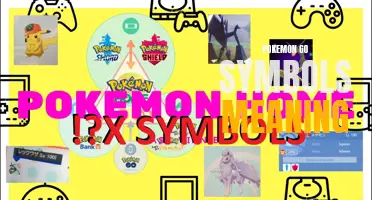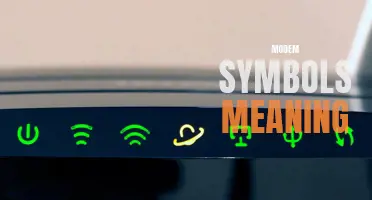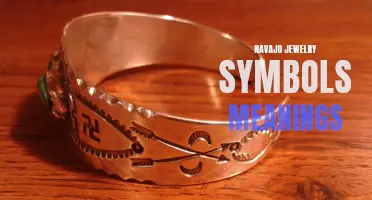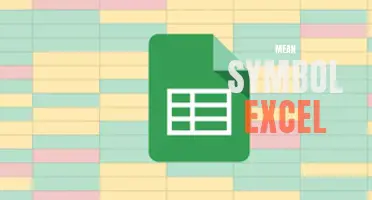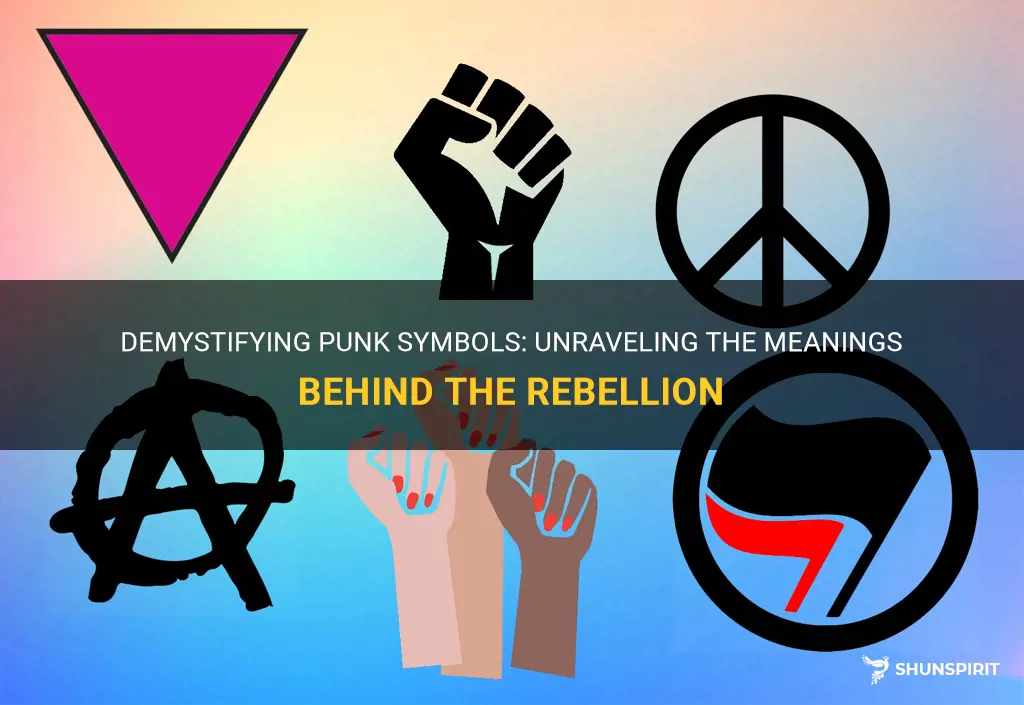
Punk symbols and their meanings have always been a cornerstone of the punk subculture. From the safety pin to the anarchist symbol, these symbols encapsulate the rebellious and nonconformist spirit of punk. Each symbol carries its own unique significance, representing different ideologies and movements within the punk community. Exploring the world of punk symbols is like delving into a visual dictionary of rebellion and resistance, uncovering the rich history and cultural significance behind these iconic emblems. Whether you're a punk enthusiast or simply curious about this influential counterculture, understanding the meaning behind these symbols is essential to gaining a deeper appreciation for the punk movement as a whole. So, let's dive into the vibrant world of punk symbols and discover the stories they have to tell.
What You'll Learn
- What are some common symbols associated with the punk subculture and what do they represent?
- How have punk symbols and their meanings evolved over time?
- Are there any specific symbols that are unique to different punk subgenres?
- How does fashion play a role in communicating punk symbolism and meanings?
- Are there any controversial or contested symbols within the punk community, and why?

What are some common symbols associated with the punk subculture and what do they represent?
The punk subculture is known for its rebellious and anti-establishment attitudes, as well as its distinct fashion and music. Along with these features, there are several symbols that are commonly associated with punk and have become iconic representations of the subculture. These symbols serve as a form of visual communication that conveys the values and ideals of punk.
One of the most recognizable symbols of punk is the safety pin. Originally used as a practical item to hold clothing together, the safety pin became a punk symbol in the 1970s when it was adopted as a fashion accessory. Punks would often wear safety pins on their clothing, sometimes even through body parts like ears or noses, as a statement of their nonconformity and rebellion against mainstream fashion norms. The safety pin represents the do-it-yourself (DIY) ethos of punk, as well as a rejection of consumer culture.
Another significant symbol in punk is the anarchy symbol. The circle-A symbol, consisting of a letter "A" inside a circle, represents the desire for a society without oppressive structures or hierarchies. It is a visual representation of the punk subculture's rejection of authority and its call for individual freedom. Punks see anarchy as a way to challenge and dismantle existing power structures, promoting anti-authoritarianism and encouraging self-governance.
The Mohawk hairstyle is another symbol associated with punk, particularly the punk rock music scene. This hairstyle involves shaving the sides of the head while leaving a strip of longer hair running down the middle, which is often spiked with hair gel or wax. The Mohawk became a symbol of rebellion and nonconformity in the punk subculture, signifying a rejection of mainstream beauty standards and a desire to stand out from the crowd. Additionally, the process of creating and maintaining a Mohawk requires effort and dedication, further reflecting the punk DIY ethos.
Punk fashion also frequently includes the use of band patches and buttons. Punks often display patches of their favorite bands or political messages on their jackets or backpacks. These patches serve as a form of identity and expression, showcasing the wearer's musical taste or political affiliations. Similarly, buttons with slogans or band logos are commonly worn as a way to convey ideas or show support for particular causes or artists.
The use of skulls and crossbones is another prominent punk symbol. This symbol represents a memento mori, reminding punks of the transience of life and the nihilistic mindset that often accompanies the subculture. It also serves as a visual representation of punk's association with death, darkness, and a rejection of societal norms.
In conclusion, the punk subculture is rich with symbols that communicate its values and ideals. From the safety pin and anarchy symbol to the Mohawk hairstyle and band patches, these symbols represent rebellion, nonconformity, DIY ethos, and a rejection of authority. Together, they create an iconic visual language that has come to define punk.
The Symbolic Meaning of Donkey in the Bible: Lessons of Humility and Service
You may want to see also

How have punk symbols and their meanings evolved over time?
Punk culture emerged in the 1970s as a means of rebellion against mainstream society. With its raw and energetic music, DIY aesthetic, and anti-establishment attitude, punk quickly became a subculture known for its distinct symbols. These symbols, often displayed on clothing, accessories, and album covers, were used to express the punk ideology and to identify others within the scene. Over time, the meanings and interpretations of these symbols have evolved, reflecting the changing landscape of punk culture.
One of the most recognizable symbols of punk is the safety pin. Originally worn as a fashion statement, safety pins became associated with punk after they were famously used to hold together torn clothing and leather jackets. This symbol represented the DIY ethos of the punk movement, as individuals would customize their outfits and make creative use of materials readily available to them. The safety pin also became a sign of solidarity within the punk community, a way of identifying fellow punks and creating a sense of belonging.
Another iconic symbol of punk is the anarchic "A" symbol. Derived from the circled "A" used by anarchists, the punk version features the "A" within a circle and is often accompanied by a barbed wire or a crown of thorns. This symbol represents the punk ideology of challenging authority and advocating for individual freedom. It is a symbol of resistance against oppression and conformity, as well as a reminder of the punk movement's roots in political activism.
As punk culture evolved, so did its symbols. In the 1980s, the use of the anarchy symbol expanded to include variations that incorporated the "A" with other symbols, such as the peace sign or the skull and crossbones. These combinations reflected the diversity of punk ideologies and the merging of punk with other countercultural movements.
Another symbol that emerged in the later years of punk is the black flag. Originally associated with the punk band Black Flag, this symbol represents the punk ethos of nonconformity and rebellion. The black flag, often displayed with a white logo, has become a widely recognized symbol of punk and is often used to denote anarcho-punk bands and events.
In recent years, punk symbols have continued to evolve, reflecting the changing social and political landscape. Symbols such as the raised fist, which has long been associated with activism and resistance, have become more prevalent within punk culture. The use of other countercultural symbols, such as the rainbow flag, has also become more common, highlighting the intersectionality and inclusivity of punk.
Overall, punk symbols and their meanings have evolved over time, reflecting the growth and diversification of punk culture. While some symbols, such as the safety pin and the anarchy symbol, have remained iconic throughout the years, new symbols have emerged to represent the changing attitudes and values within the punk community. Regardless of the specific symbols used, their purpose remains the same - to express individuality, resist conformity, and create a sense of belonging within the punk subculture.
Understanding Omron Symbols: What Do They Mean and How to Interpret Them
You may want to see also

Are there any specific symbols that are unique to different punk subgenres?
When it comes to punk music and its various subgenres, symbols play an important role in representing the ideologies and aesthetics of different movements within the punk scene. While there are some common symbols that are associated with punk as a whole, there are also specific symbols that are unique to different punk subgenres. These symbols serve to differentiate and identify the subgenres, allowing punks to express their individuality and allegiance to their chosen movement.
One of the most recognizable symbols in the punk scene is the Anarchy symbol. This symbol, which consists of an "A" enclosed in a circle, is commonly associated with punk music and represents the rejection of authority and societal rules. The Anarchy symbol is often incorporated into band logos, album covers, and even tattoos. However, while the Anarchy symbol is widely used in the punk scene as a whole, it is not specific to any one particular subgenre.
On the other hand, certain punk subgenres have developed their own unique symbols that represent their distinct ideologies and aesthetics. For example, in the hardcore punk subgenre, the Black Flag bars have become an iconic symbol. The Black Flag bars consist of four thick, black vertical lines, symbolizing the bars of a prison cell. This symbol is associated with the hardcore punk movement's anti-establishment and anti-authoritarian stance.
Another subgenre that has its own set of symbols is the pop punk subgenre. Pop punk often incorporates elements of pop music into punk rock, resulting in a more melodic and catchy sound. One of the symbols commonly associated with pop punk is the smiley face. The smiley face symbol represents the more lighthearted and upbeat nature of the pop punk subgenre.
In addition to these specific symbols, each punk subgenre may also have its own unique fashion styles, hairstyles, and color schemes that further distinguish it from other subgenres. These visual elements often work in tandem with the symbols to create a cohesive aesthetic that represents the subgenre's values and ideals.
However, it is important to note that punk is a fluid and diverse genre, and many bands and individuals within the scene may not strictly adhere to any one subgenre or its associated symbols. The punk scene is known for its inclusivity and acceptance of individuality, so it is not uncommon to see punk fans and musicians incorporating elements from multiple subgenres into their personal style and expression.
In conclusion, while there are common symbols that are associated with punk music as a whole, there are also specific symbols that are unique to different punk subgenres. These symbols serve to differentiate and identify the subgenres, allowing punks to express their individuality and allegiance to their chosen movement. From the Anarchy symbol representing the rejection of authority, to the Black Flag bars symbolizing hardcore punk's anti-establishment stance, to the smiley face symbolizing the lighthearted nature of pop punk, these symbols play an important role in the visual representation of the various punk subgenres.
A Guide to Understanding the Symbols Next to Text Messages on Android
You may want to see also

How does fashion play a role in communicating punk symbolism and meanings?
When it comes to punk culture, fashion is much more than just a style statement. It plays a crucial role in communicating the symbolism and deeper meanings associated with the punk movement. From its very inception in the 1970s, punk fashion acted as a means of rebellion and self-expression for those disillusioned with mainstream society. The clothes, hairstyles, and accessories chosen by punks were deliberately designed to shock and challenge societal norms.
One of the most significant ways punk fashion communicates its symbolism is through its rejection of traditional beauty standards. Punks purposely embraced unconventional looks, often experimenting with asymmetrical hairstyles, body modifications, and bold makeup. By doing so, they rejected the idea that beauty should conform to a specific mold and instead celebrated individuality and uniqueness.
Punk fashion also uses DIY (Do-It-Yourself) aesthetics as a means of countercultural expression. Punks often created their own clothing and accessories using cheap materials and unconventional techniques. This DIY ethos not only allowed punks to reject consumerism and the fashion industry but also allowed them to assert their independence and creativity. It communicated the DIY spirit of punk and reminded the mainstream society that fashion could be something personal and authentic.
Furthermore, punk fashion often utilized provocative and subversive imagery to challenge societal norms and spark conversations. Punk bands and artists frequently incorporated symbols like safety pins, razors, anarchy signs, and band logos into their clothing designs. These symbols served not only as an expression of punk ideology but also as a way to provoke and shock the audience, forcing them to confront their own beliefs and assumptions.
Additionally, the punk subculture adopted a distinct color palette that further contributed to its symbolism. Black, with its associations with rebellion, darkness, and non-conformity, became the signature color of punk fashion. It conveyed a sense of defiance and outsider status, setting punks apart from the mainstream. However, punk fashion also embraced bright and vibrant colors, often used as a deliberate contrast to the dark and monochromatic looks. This contrast symbolized the punk movement's desire to disrupt and challenge societal norms, going against the expected norms of fashionable dressing.
In conclusion, fashion within the punk subculture plays a fundamental role in communicating the movement's symbolism and meanings. Through deliberate rejection of traditional beauty standards, DIY aesthetics, provocative imagery, and a distinct color palette, punk fashion acts as a powerful tool of self-expression and rebellion. It challenges societal norms and emphasizes the importance of individuality, authenticity, and non-conformity. By donning punk fashion, individuals send a message to the world about their rejection of mainstream values and their commitment to embracing their own unique identity.
Understanding the Meaning of Mini Cooper Fuse Box Symbols
You may want to see also

Are there any controversial or contested symbols within the punk community, and why?
Within the punk community, there are several symbols that have been the subject of controversy and contention. These symbols often represent different ideologies and perspectives within the punk movement, leading to debates about their meaning and appropriateness.
One of the most controversial symbols within the punk community is the swastika. Originally a symbol of good luck and auspiciousness in Hinduism, Buddhism, and Jainism, the swastika was appropriated by the Nazis during World War II and has since become associated with hate, racism, and genocide. Some punk bands and individuals have used the swastika as a provocative and confrontational symbol, intending to shock and challenge societal norms. However, many others argue that the use of the swastika in punk is offensive and disrespectful to the millions who suffered under the Nazi regime and perpetuates hate speech and discrimination.
Another contested symbol within the punk community is the anarchy symbol. The anarchy symbol, often represented as a letter "A" within a circle, has been adopted by punks as a rejection of governmental authority and a call for individual freedom and autonomy. However, the meaning and interpretation of the symbol can vary widely. Some punks view anarchy as the absence of all rules and regulations, while others see it as a political ideology advocating for a stateless society. This diversity of interpretation has led to debates and disagreements within the punk community about the true meaning and purpose of the anarchy symbol.
Similarly, the use of the Confederate flag within the punk community has also sparked controversy. The Confederate flag, originally a symbol of the Confederacy during the American Civil War, has become associated with racism, slavery, and white supremacy. Some punk bands and individuals have used the Confederate flag as a means of provoking and challenging societal norms. However, many others argue that the Confederate flag represents a legacy of oppression and hate, and its use in punk is inappropriate and offensive.
In addition to these symbols, there are also disputes over various band logos and album cover art within the punk community. Some album covers, such as the Dead Kennedys' "Frankenchrist," have faced censorship and controversy due to their explicit and provocative content. The use of controversial symbols and imagery within punk album art often sparks debates about free speech, artistic expression, and the potential harm caused by offensive or harmful content.
Overall, the punk community is no stranger to controversy and contention over symbolic representations. These symbols often carry significant meaning and can spark intense debates about their appropriateness and impact. While some argue that these symbols possess power and provoke important discussions about societal issues, others believe that their use perpetuates hate speech, discrimination, and harmful ideologies. As the punk community continues to evolve and grow, these debates are likely to persist, challenging the boundaries and values of the movement.
Understanding the Symbolic Meaning of the Coqui Taino Symbol
You may want to see also
Frequently asked questions
The most common punk symbol is the anarchy symbol, which is a letter "A" surrounded by a circle. It represents the belief in a state of disorder and the rejection of authority and hierarchy. This symbol is often associated with punk ideology and the desire for political change.
The safety pin is a prominent symbol in punk culture and it represents a form of DIY (do-it-yourself) ethos. It originated from the punk fashion movement in the 1970s, where punks would use safety pins to fasten their clothes and accessories together. The safety pin symbolizes individuality, rebellion, and the rejection of mainstream fashion.
The "Oi!" symbol is closely associated with punk music and it originated from the working-class punk subculture in the United Kingdom. The term "Oi!" was used as a rallying cry, expressing unity and solidarity among working-class punks. The symbol is often used to represent the raw and energetic sound of punk music, with lyrics that touch upon social and political issues.
The skull symbol is widely used in punk art and it represents mortality, rebellion, and an anti-establishment sentiment. The skull is often depicted with punk elements, such as mohawks, spiky hair, or safety pins, to emphasize the punk aesthetic. It serves as a reminder of the punk philosophy of embracing the present moment and challenging societal norms.



